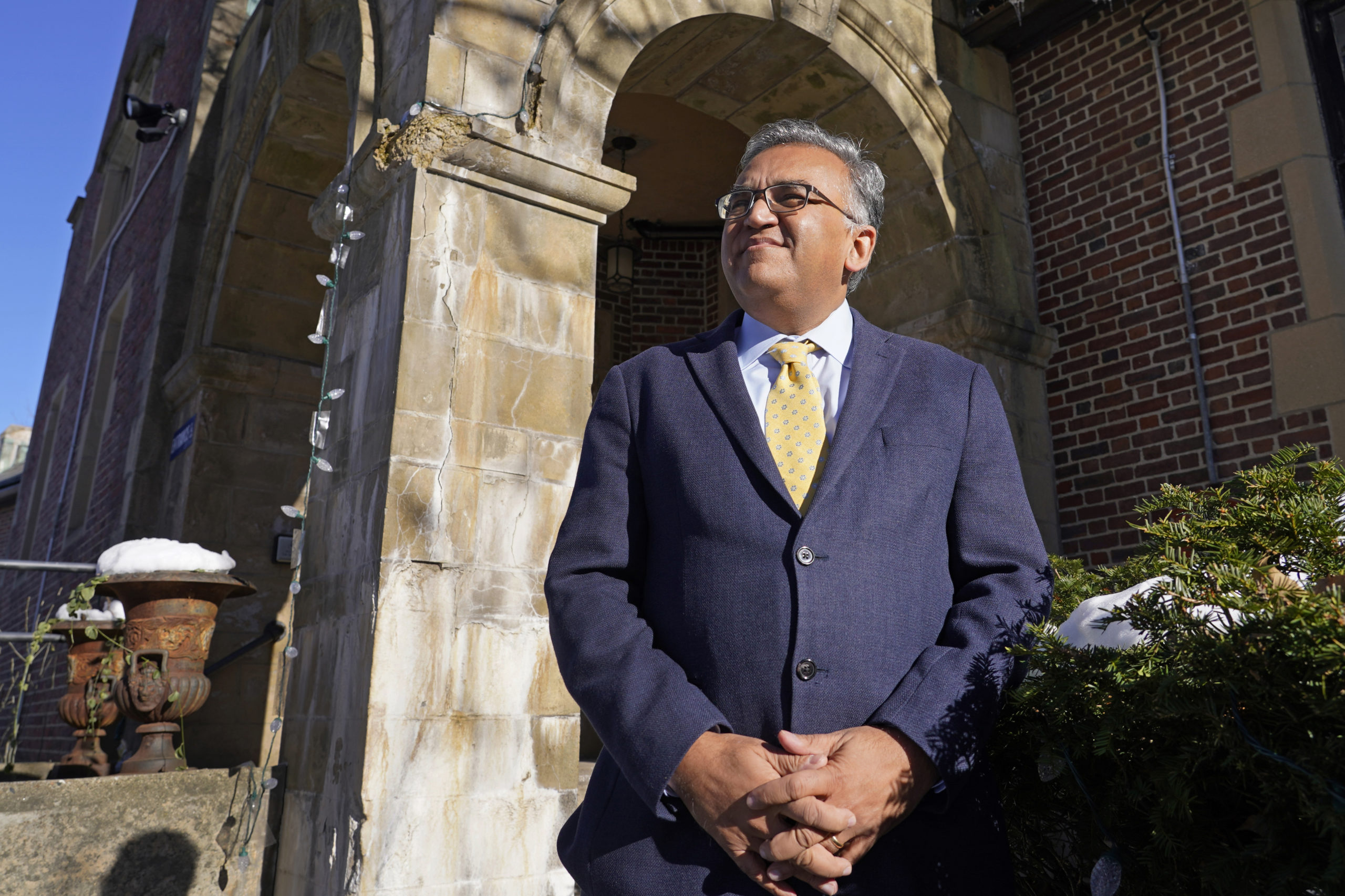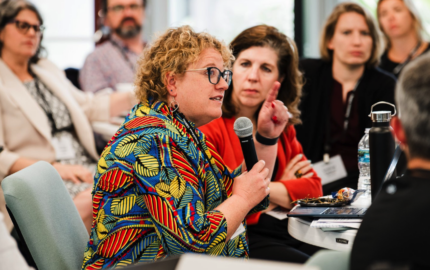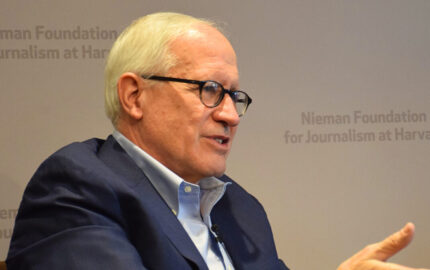By the spring of 2021, one year into the pandemic, a return to normalcy seemed on the horizon. Vaccine availability was on the cusp of becoming more widespread in the United States, and masking and social distancing restrictions were loosened soon after. By the end of the summer, however, the Delta variant had run rampant across the globe; months later, Omicron would follow. Now heading into the pandemic’s third year, new questions and uncertainties loom: What new variants await us? How can vaccines be equitably distributed worldwide? And at what point will the coronavirus become endemic?
From the pandemic’s start, Dr. Ashish Jha has reflected on these questions and many more. A leading expert on pandemic preparedness, Jha has served on the frontlines of the Covid-19 response, offering analysis and guidance to state and federal policymakers. Recently appointed as the new White House Covid-19 response coordinator, Jha is also dean of Brown’s School of Public Health and previously taught at the Harvard T.H. Chan School of Public Health and Harvard Medical School. His research has appeared in over 200 publications, and he has contributed to multiple public media outlets.
Jha spoke with the Nieman Foundation in February about the press’ role in relaying public health directives, misinformation, and more. Edited excerpts:
On finding a middle ground on policy
I thought of the acute phase of this pandemic that’s lasting about 18 months and thought that the major disruption to our lives was going to last about that long.
My mental model was [that] at about 18 months in, we’d have pretty good vaccines. They’d be reasonably widely available, and sometime by the summer of 2021, we would be in much better shape. I looked like a genius in the spring of 2021 and then like an idiot by the fall of 2021.
It did play out that it looked like by spring into early summer things looked like they were getting better, and then the Delta wave hit the United States and then Omicron. We’ve come to realize that this virus is turning out to be very different than we expected.
There are two years of fatigue setting in. No politician likes to tell people, “Let me tell you the things you cannot do.” That’s not a classic way to run for election. “I’m going to become prime minister or president so I can restrict your movement, restrict who you see, make you wear a mask.” These are things that political leaders do with a lot of trepidation.
What I’m worried about at this moment is that, therefore, the alternative is do nothing. What we’re entering into is this idea. You’ve all heard of this idea. “We’ve got to learn to live with this virus.” That has become code for, “We got to act like the virus doesn’t exist and just go back to 2019.”
Somewhere between, “Go back to 2019,” and really strong and very unpopular public health restrictions lies the path that we actually have to take. It’s hard for political leaders to see that because the two messages they get are, “2,000 Americans are dying every day. You’ve got to do more,” or, “We’re two years in. We’ve got vaccines. You’ve got to stop everything.”
The challenge for them is, how do they find the middle path on policy? Then the bigger challenge is, how do they communicate that to their people so that it feels politically palatable? That’s hard.
On how the media can help the public better understand the pandemic’s bigger picture
There was uncertainty in March of 2020. There is uncertainty in February of 2022. They are very different types of uncertainty.
Explaining in some ways and helping people understand how we’re in a very different place, and mostly a much, much better place. I don’t mean to use “different” without some judgment there. There’s a lot that’s much, much better now than where we were two years ago.
For instance, I have no idea whether Omicron is going to be the last clinically and public health‑wise important variant. I suspect it’s not. I suspect we will get to know many more letters of the Greek alphabet. Those variants may look very different than Omicron.
Acknowledging that is the future we have to understand and prepare for, [and] speaking openly and honestly about those kinds of things, is extremely important. I don’t know that I see a lot of that in journalism. There are some good pieces. It’s not that that’s not happening.
That kind of thing has become a large part of journalism with Covid [is], “The latest cases are down 10,000. We’re heading towards endemic.” The longer pieces that provide that broader context, there are people riding it.
Those are the things that need to be done more of to help people understand that yes, infection numbers will come down. They will go back up. That’s not the most important thing that people need to understand. The most important thing people need to understand is the broader picture of where we are and where we’re going.
The bigger picture is helping people understand the long arc of the pandemic and where we are in that arc.
That’s the part that I find most people are confused about. There are people who feel like we’re in the beginning of this pandemic. There are other people who think we’re at the end of this pandemic. Mostly, people are just confused about what’s going to happen next.
To the extent that we can all — you all as journalists, [and] those of us who are public health communicators — to the extent that we can help people understand that broader arc and where we are in it right now, that would be really helpful.
On misinformation
Obviously, misinformation has been a huge problem in the United States throughout the whole pandemic. One thing I’m always reminded of is [that] Facebook, Twitter, and YouTube also exist in Europe. Misinformation exists in Europe.
Then the question is why are the Europeans so much less susceptible to misinformation? It is not that they’re not susceptible at all. We see the rallies and the anti-vax movement, but they’re just much smaller as far as I can tell, certainly by the evidence, in most European countries. I try to understand why that is.
I look at places, for instance, like Puerto Rico in the United States — phenomenal vaccinations. Just amazing vaccinations. Early and sustained. Then, we try to dig into why. Are they wealthier? No, they’re not all that wealthy. Did they have early access? No. They had access at about the same time, maybe even a little bit later.
One of the things that is going on is if you look at the major political parties in Puerto Rico, they’re all very pro‑vaccine. They fight about all sorts of other stuff: statehood, not statehood, a bunch of other issues. As far as I can tell, the political parties are largely all fully aligned on vaccines. That is not true, in many ways, on the U.S. mainland.
My best sense of this is that most people, as much as they may say they’re doing their own research, really are not doing their own research. What I mean by that is what do their political leaders that they trust to say? Other people whose opinions they value, what are they saying about these vaccines? When you have both vaccines and masks pretty politicized … I will tell you, I’ve been disappointed.
There are plenty of Republicans who’ve been terrific on vaccines. Still, [there] a lot of Republican leaders who played footsie, as it goes, with a lot of anti‑vax folks. Not really condemning it, kind of tolerating it, and signaling that they’re actually not that strongly pro‑vaccine. That has really caused huge problems.
That’s one reason why misinformation sticks, is because if your political leaders that you trust, with whom you identify, are not being stalwarts on vaccines, it’s going to be much, much easier for you to be susceptible.
There is also one other issue which is not at all trivial, which is there are large chunks of the American population, largely racial ethnic minorities, who have had a long history of distrust of the government, for good reason, in the way that they have been treated.
In that context, misinformation about vaccines and other pandemic stuff has also found fertile ground, and that also continues to be a challenge. This is something I struggle with and think about all the time. How do we understand the misinformation that’s killing us?
Almost everybody who’s dying right now is dying because of misinformation. If every adult had gotten vaccinated and boosted, we’ll have close to no deaths or very small number of deaths from Covid. Almost all the deaths right now are from misinformation. That is a real problem.
On moving away from predictions
The one feature of this pandemic has been that everybody who has made predictions has been wrong. It’s been really hard to predict all the twists and turns of this pandemic.
I expected more variants. I don’t know that I saw Omicron and its features coming because it was a little bit out of left field. If you look at the virus and how it has evolved, I expected something of the branches of Delta or maybe Beta. Omicron is just something totally unlike anything else. It’s a reminder that Mother Nature has lots of tricks up her sleeve.
Our ability to predict what the next variant is going to be, what it’s going to look like, where it’s going to come from, when it will show up, is limited. That’s the big picture. Anyone who tells you, “We are now in an endemic phase,” or, “We are now this,” [you] just have to take that with a large grain of salt.
It doesn’t mean that we shouldn’t do any prognostication or prediction. It’s reasonable to say, “I expect that infection numbers are going to decline over the next three, four weeks. I expect that by the time we get into March, infection numbers will be very low across much of the country.” Those are predictions. That’s what I expect.
Instead of focusing on trying to get the prediction perfectly right, we should focus on the fact that there are enough curveballs that we should plan on, “What if I’m totally wrong? What if we see a new variant show up much sooner than any of us were expecting? What if the next variant is far more serious and far more deadly than Omicron or Delta?”
We should plan for those things and then figure out, “How do we keep our schools open? How do we keep businesses open? How do we let people get to work safely? How do we make sure our hospitals don’t get filled up?”
We can do all of that, but we’ve spent so much energy focusing on prediction. We’ve spent far too little energy focusing on preparing for those things. By the way, if it turns out that I’m wrong and there are no future variants and no future surges and we’re done with the worst of it, great. Who’s going to be unhappy with that outcome?
I get asked probably about once or thrice a day. “Are we endemic? When does this virus become endemic?” My question back to people generally is, “What do you mean [by] endemic?”
There’s an article I was reading last night that had this point, which the unfortunate part of the word “endemic” is it starts with the word “end.” People think of endemic as like the end of the pandemic. It’s not where the word actually comes from, right?
There’s no consensus on what is endemic. I’ve stopped using the term. The virus is going to be around for a long time. We can learn to live with the virus. We can learn to live with it in a way that won’t kill thousands of Americans every day, won’t shut down our healthcare system. We’ve got to be humble and respectful of what Mother Nature can do and prepare for it.




